Quito to Cuenca, Ecuador
18/1/10 to 18/2/10 657 km
Santiago’s house is a relaxing place to be. His Casa de Ciclistas is just east of Quito, in Tumbaco. He is frequented by many local cyclists that want their bike fixed, and Santiago and Juan Manuel, a 15 year old Colombian work all day on bikes. 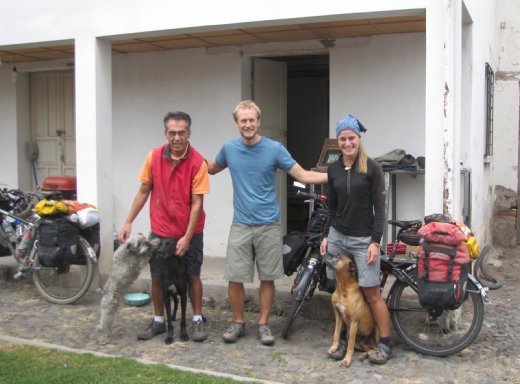
From Tumbaco a good bus system connects to Quito, so we visit the city a few times.
Nearby Tumbaco is an old railway track, now turned into bike path, which all the local bikers ride up and down on weekends. One morning we set out with Santiago and his wife Ana Lucia on this ‘chaquiñan’. It’s a sandy trail that leads to a pretty canyon, drops down to the river and then climbs back up the other side. On the way up we cross a number of dark tunnels. After a refreshing juice at the top we turn around to head back. I’m behind Ana Lucia and a bit wary of the dark tunnel now on a downhill slope. As I enter I suddenly make out figures on the ground and slow to stop. On the tunnel floor is a mess of bikes and people. I hear Ana Lucia groan. I see her leg. A big gash of a wound under her knee. The only way to get to the road is walking back up the trail, and Ana Lucia manages to sit on Ali’s rear rack, while he and another cyclist push the bike uphill. The surgeon spends over an hour rejoining muscle sheet and skin. What a nasty accident hidden behind the corner. It’s a warming sight to see Ana’s six sisters visiting that evening, all seated on her bed and caring for her.
Saying goodbye is a little sad, but in the knowledge that we will return in 3 months time when my mother and brother will come to visit.
We set off on a rode leading to Cotopaxi Nationl Park. Cotopaxi is the second highest active volcano in the world and a beautiful cone shaped peak covered in snow and ice.
We camp on a grassy field in Rumipamba and feel amazed that in 3 hours cycling from Quito we are back on the not so trodden trails. From Rumipamba the rough and sometimes steep cobblestone road climbs up to the northern entrance of the park. Cotopaxi is covered in cloud, which occasionally divides in blue patches through which we can just see the peak.
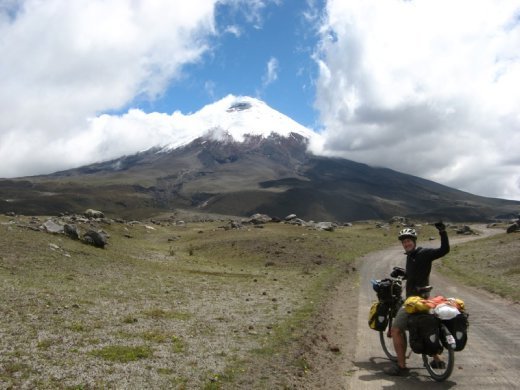
Sheryn, a good friend from Adelaide sent us a big parcel full of Australian goodies, so during breaks we enjoy vegemite sandwiches, earl grey tea and Arnott’s biscuits!! Thanks!

In the distance wild horses are startled by our presence, and the views of Cotopaxi get better and better. We ride on a rocky washboard road weaving it’s way through a boulder strewn grassy paramo landscape with views of no less than 5 volcanoes.
We camp in a shack at the campground and hide our bags the next morning to get higher up unloaded. A van takes us 8 kms from the pass at 3800 meters to a parking lot at 4600, from where we walk to a refugio. It’s blowing a gale up this high and it’s challenging to stay upright on the way up to the refuge. After hot chocolate we walk down to our bikes for an awesome descent down the volcano.
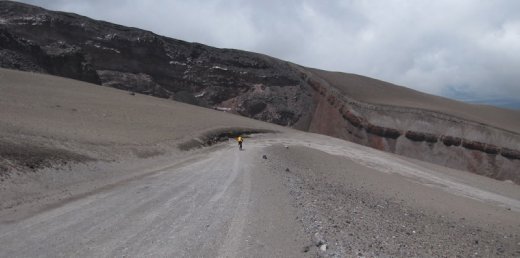
Happy to find our bags untouched in the bushes we ride down another 1000 meters to the Panamericana. It’s amazing how one gets used to quiet roads and we both get pretty nervous of all the traffic. Fortunately it’s only 5 kms to the next backroad.
We are lucky, because we are in Saquisili on market day. Of all the markets we have seen, I think this is the most impressive one: there are 5 squares, and every square has its own ‘theme’. We walk though the vegetalble market in awe. There are hundreds of women, wearing hats and long skirts and colourful shawls. Some are sitting on top of a pile of corncobs or peas, pealing them whilst chatting with the woman on the pile next to them. There are thousands of bags of potatoes, and between all those vegetables, women and men, most a head smaller than I, are walking with one or two 50 pound bags on their shoulders. They have to walk fast, or else they tip over, so everybody jumps to the side quickly when someone with a load has to pass.
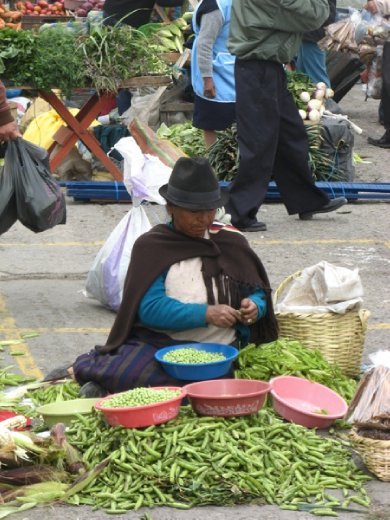
After the vegetable market we wander through the ‘small animal market’. Big reed buckets are filled with guinea pigs, rabbits, chick, cats and puppies. The bargaining over the guinea pigs is especially passionate. It’s traditional food in the highlands.
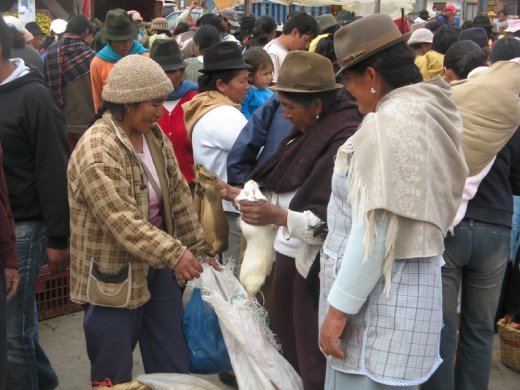
Men are sitting behind Singer sowing machines and adjust clothes on the spot. A man surrounded by an indigenous crowd sells cheap buddha statues and promises his buyers everlasting happiness and large amounts of money for the future.
We planned to ride the ‘Vuelta de Quilotoa’ is a circuit of highland villages south of Quito. It’s named after the crater lake Quilotoa, and known for its indigenous markets.
I knew I had been stupid, a few days before, when I shared cookies with an old indigenous lady, who was coughing and told me a little later she had a flu.
The evening before our departure I felt shivery and weak. It was friday, and saturday would be market day in Zumbahua. We decided to take a bus up, so we could still see the market.
Zumbahua is a small village, settled around a market square. When we arrive, the square is empty and clean. We get a room looking over the square at ‘Condor Matzi’ (thanks Jeff) and friday night hundreds of stalls are erected below our window.
At 6 am we wake up with Andean highland whistle music. The square is choc-a-block full of stands. The market is similar to the one in Saquisili, just at smaller scale.
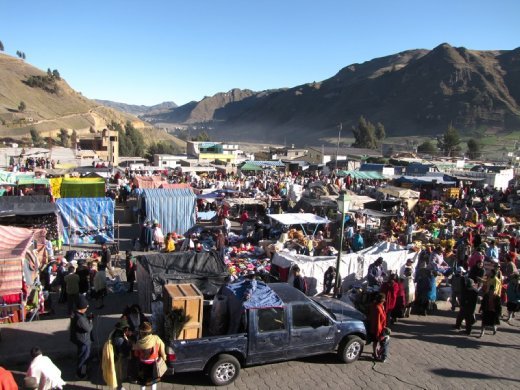
At 4 pm it suddenly starts to rain, and within minutes the whole market is packed down. Women bind plastic bags around their hats and run off. Only streetdogs are left at the scene, hoping to find a meal between all the garbage left behind on the square.
We ride 13 kms to Quilotoa, a climb that takes us three hours. I’m still feeling sick and have to rest every 500 meters. In Quilotoa we spend a couple of days with Mez and Jeanette (Australia and Canada respectively), two friendly backpackers. Jeanette is making a documentary pilot on her travels about alternative medicine and solo women travellers, recording people she meets on her way, and does an interview with us close to laguna Quilotoa.
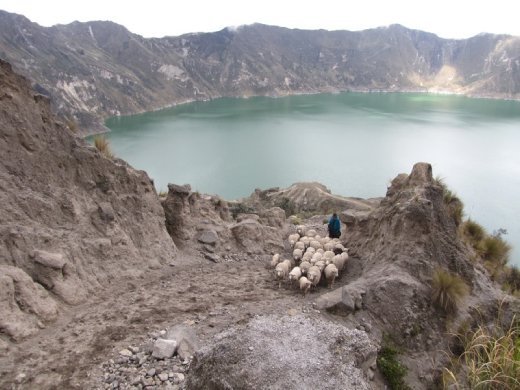
From Ambato leads a beautiful route around volcan Chimborazo, Ecuadors highest mountain at 6310 m. On the first day up we ride up through a beautiful deep canyon on a ‘via turistica’ towards Guaranda. We had been told of some nice hotsprings after 45 km, and hope spending the night there. But when we get there the price is higher for ‘gringo’s’ and the pools don’t look all that attractive. Besides that everybody in the village seems drunk on ‘aguardiente’ (local cane firewater), so we decide to ride on. Only minutes later we are rewarded with awesome views of a white capped Chimborazo. We are allowed to stay at an internate. At night we are alone with Paco (14) and David (8). I ride their horse, eat popcorn and talk about ‘el señor de los anillos’ (lord of the rings) while sharing dinner with these two boys.

The second day starts of great. There is a strong wind. Tailwind! We ride almost without pedaling, 14 km/h, from 3600 m to 4000 m. The surroundings get dryer and dryer, there are only brown coloured small bushes. In the distance are vicuñas, the wild cousin of the alpaca.
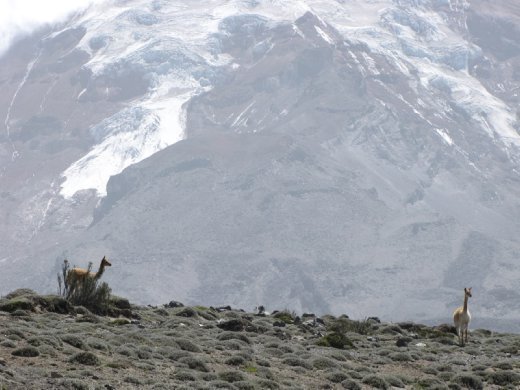
Then we take the turn off to Riobamba. Bam, there is the wind, from the front and the left. We start of cycling, but every time a car passes there is a second of ´wind stop´ and then the ´slam´ of the wind. Because of this we meander so much that it becomes dangerous to ride. The road turns and the wind is so forceful that we have to walk. In the distance we see the pass at 4300 meters. And then as suddenly as the wind started, she´s gone. We are in the lee side of Chimborazo, now on our left. Beautiful this is, this desert landscape with a giant mountain covered in snow and glaciers. These glaciers are amongst the fastest retreating glaciers in the world. I wonder what it will look like up here in 10 years. We see more vicuñas. Then the wind starts again. Cold and a little shaken by all those forces of nature we seek shelter in a new info centre just after the pass. After that, the road drops, deep down to the valley, and the landscape changes quickly from desert to pasture with cows and llamas to villages.
We continue through the highlands. The road climbs and descends, climbs and descends, the dogs get more aggressive, the indigenous people aren´t as friendly as before and often just stare at us passing. Two days we ride in the mist, not seeing much more then 50 meters in every direction.
A highlight of this section are the nights that we spend at the bomberos/ firefighters. The firefighters have a ´traveller friendly´ attitude, and there is always a room where we can lay out our mats. There is usually a shower and a kitchen. Some have a big station with sauna, jacuzzi and a volleybal court, others are smaller. The guys are all into playing ‘Ecuavolley’, a form of volleyball with a very high net and three people each team. Sometimes they leave us alone, sometimes they come for a chat or even share with us some of their mother-in-laws traditional cooking. Usually the smaller the station the friendlier the ‘bomberos’ and in El Tambo we spend a really relaxed and enjoyable night with the local crew.

The next day from El Tambo we visit Ingapirca, Ecuadors most important archeological site. It was built by the Incas in the 15th century. It´s the first time we see Inca ruins on our trip as we cross the ancient Incan Trail from Cusco to Quito. Unfortunately in Ecuador most of the significant ruins have been pillaged for stone and other buildings, so Ingapirca is one of only a few good examples of Incan sites left in Ecuador. They didn´t use mortar, so all stones are sculpted exactly the right shape. It isn’t exactly a huge site, but it is a taste tester for the Incan sites further south in Peru, and still quite impressive in it’s own right.
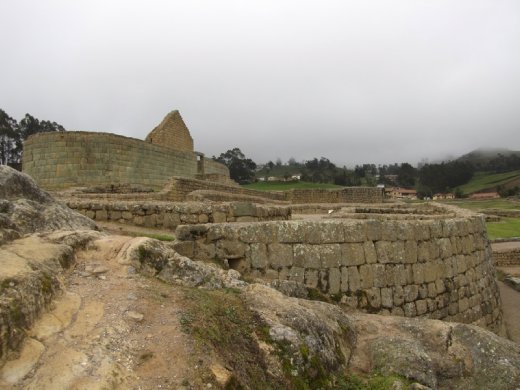
In Cuenca we stay with Wilson and his family. Wilson is a friend of Santiago. The family is extremely hospitable, we even sleep in Wilson’s bedroom, who therefore moves to his sisters room.
We visit Alberto Pulla, one of the most well known Panama hat makers. Alberto can´t speak after a tracheotomy. But he´s a sweet man, and has us try all sorts of hats. He´s has everything from ´normal´ to ´superfino´, the difference is how finely the palm leaves have been split before braiding the hat. Most people don’t realise that Cuenca in Ecuador is the actual ‘home’ of the Panama hat.
Ali has had problems with his Rohloff hub since the past month. First he missed one, then two, then four, then six gears. Fortunately he could still ride, but we were worried that it would deteriorate further rather than improve by itself. After an email to Rohloff they immediately sent us a new internal mech to Santiago’s house in Tumbaco. Our plan was to bus back from Cuenca to Quito, to change the gear mech with Santiago’s tools.
But...all doesn’t go to plan. Ali eats something bad and gets food poisoning. A day later we hear the hub has been in Ecuador for 5 days already, but customs in Guayaquil doesn’t want to ‘release’ the parcel until a 500 dollar tax is payed. The have ‘revalued the gear mech’ to the shop price of a new hub and put a 65 % tax on this. The only way to talk with customs is face to face, so we get a bus to Guayaquil, in the hot western lowlands of Ecuador.
The next day we are at the customs office early. We talk with the ‘jefe de courier’ (the boss), thankfully a very friendly woman. She wants to call Rohloff to find out the actual value of an internal mech. But it’s weekend in Germany and after this day there will be 4 days of carnaval in Ecuador. We ask if she can please do something else, since we don’t feel like hanging around 6 days until wednesday in Guayaquil. After this, we learn a good deal of pure Ecuadorian bureaucracy....luckily on this day to our advantage. The ‘jefe’ finds the value of another hub they have once imported in their computer system (a hub that has absolutely nothing to do with our Rohloff), and tags this to our parcel. Suddenly the 65 percent tax drops to a 20 percent tax, and that over a much smaller value. The US$500 import tax gets downgraded to US$50. We wait the rest of the day in the oppressive heat until this money trick has been ‘transferred into the system’. At 17.15 we walk out completely drained but happy to the bus station, the new internal Rohloff gear mech safely in our hands and onto the night bus to Quito.
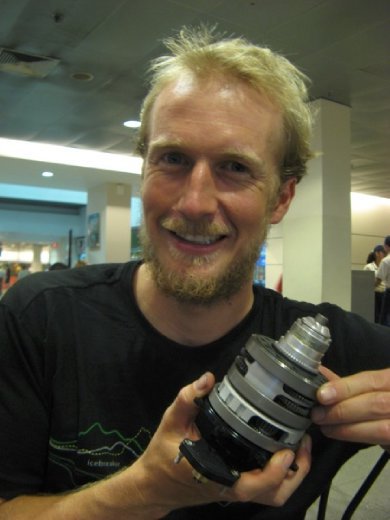
The next morning we are warmly welcomed by Santiago and Ana Lucia. We stay a few days in Tumbaco, to rest, to replace the gear mech, and to play with the dogs Malola and Jack. Ana Lucia is walking again and her wound is healing well. We enjoy the company once again at the Casa de Ciclista, especially Ian’s, a British-Canadian cyclist also staying over. Ian cycles light and fast. It’s great to talk bikes all day with another fanatic. Ian also eats vegetarian, and re-inspires us to again eat meat and fish free. Hopefully we’ll meet again soon, he’ll catch us up anyway at his pace.
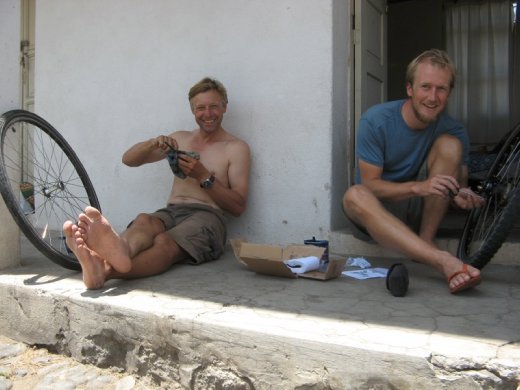
Now we are back in Cuenca, ready for some days hiking in Parque Nacional las Cajas and the last stage of Ecuador. Even though Ecuador has taken far more time than we had thought beforehand, it feels as if our time here is ´round´and things like hub and health are ready for Peru.
Love
Anna and Ali